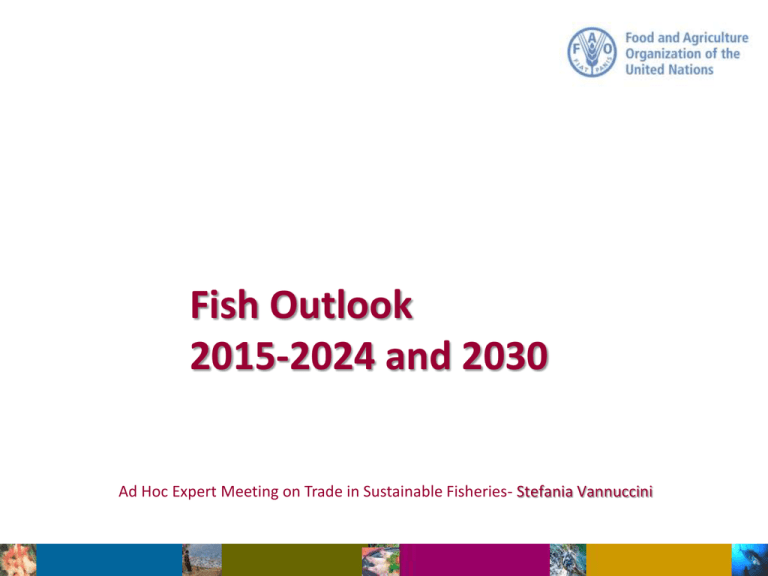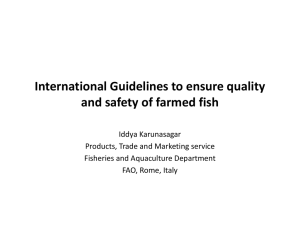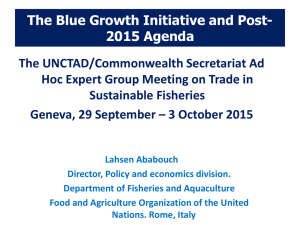Fish Outlook 2015-2024 and 2030
advertisement

Fish Outlook 2015-2024 and 2030 Ad Hoc Expert Meeting on Trade in Sustainable Fisheries- Stefania Vannuccini Outline • Background • Fishery outlook – OECD-FAO Agricultural Outlook 2015-2024 – IFPRI-WB-FAO Fish to 2030 Before starting... let’s reflect This is the BLUE planet Water About 72% of the Earth’s surface, with about 97% in oceans Healthy aquatic ecosystems are vital to human welfare What OCEANS/WATER give to us All kinds of Provisioning, Regulating, Cultural and Supporting services • Fish and plants as a source of protein and micronutrients (food) • Pharmaceutical compounds (medical cures) • Fixation of atmospheric carbon by algae • Regulation of the climate and weather trends • Provide mass transportation routes • Provide pleasure and wellbeing (recreation) •And much more… Challenge: 9.7 billion in 2050 Sustainability Status of stocks Percentage of stocks assessed 28.8% of overfished stocks in 2011 71.2% of stocks fished within biologically sustainable levels: 100% 90% 80% 70% 60% 50% 61% fully fished 10% underfished 40% 30% 20% 10% 0% 1974 1978 1979 1981 1983 1985 1987 1989 1990 1992 1995 1997 2000 2004 2006 2008 2009 2011 Constant increase of the % of fully fished stocks since 1990 Projections (Intergovernamental Panel Climate Change) The future ahead of us ? Outlook models • Understanding on perspectives of developments • Lack of specific outlook model for the fisheries and aquaculture sector • Importance to draw fisheries outlook in integration with agriculture models Two recent outcomes • FAO fish model, being published in the yearly OECD-FAO Agricultural Outlook publication since 2011 • IFPRI’s IMPACT MODEL with results published into the recent World Bank “Fish to 2030: prospects for fisheries and aquaculture” publication. Results • Projections and not forecast • Likely paths of development and constraints in fishery and aquaculture supply and demand • Determine regional vulnerabilities, changes in comparative advantage, price effects, and potential adaptation strategies in the sector • Medium/longer outlook OECD-FAO Agricultural Outlook • Joint OECD-FAO report • Country collaborators • Aglink-COSIMO, partial equilibrium model • 10 year horizon • Major temperate commodities • Global coverage Total fishery production Tonnes (live weight) 200 160 120 Aquaculture 80 40 Capture 0 1991 1994 1997 2000 2003 2006 2009 2012 2015 2018 2021 2024 Projected growth (quantity and %) Aquaculture growth +26.4 million tonnes p.a. Africa 2% North America 1% 3.0 2.7 Oceania North America Europe 2.4 2.0 Latin America & Caribbean Africa 2.5 % 40 94% in developing countries Europe 4% Latin America & Caribbean 4% 2.1 30 20 Asia 89% 10 0 Oceania 0% Asia Lower annual growth rate of aquaculture % 12 10 8 6 4 2 0 1980s 1990s 2000s 2010s 2020s Surpass of aquaculture Tonnes (live weight) Total capture 100 80 Capture for food 60 Aquaculture 40 20 0 1991 1994 1997 2000 2003 2006 2009 2012 2015 2018 2021 2024 Slight increase of capture fisheries Tonnes (live weight) 100 80 Total capture El niño 60 40 Non-food uses 20 0 1991 1994 1997 2000 2003 2006 2009 2012 2015 2018 2021 2024 More fishmeal produced from residues Tonnes (product weight) 8 6 4 El niño From residues From whole fish 2 0 1991 1994 1997 2000 2003 2006 2009 2012 2015 2018 2021 2024 Use of fishmeal in aquaculture % 0.40 Ratio of fishmeal consumption to aquaculture production 0.35 0.30 0.25 0.20 0.15 0.10 0.05 0.00 1993 1996 1999 2002 2005 2008 2011 2014 2017 2020 2023 World fishery trade Tonnes (live weight) 60 50 Trend 40 Imports excluding intra EU 30 20 10 0 1991 1994 1997 2000 2003 2006 2009 2012 2015 2018 2021 2024 Lower growth of fish consumption Kg live weight 25.0 20.0 15.0 10.0 5.0 0.0 1991 1994 1997 2000 2003 2006 2009 2012 2015 2018 2021 2024 Additional fish 31 million tonnes additional fish consumed by 2024 Developed Developing 100% Other Asia 2% Viet Nam 3% Bangladesh 3% Indonesia 8% North America 5% 90% 80% 70% 60% Africa 8% Oceania 1% 94% 83% 50% 40% 30% 20% 10% 0% Additional fish consumed Latin America & Caribbean 5% Europe 10% India 8% Asia 71% China 53% Growth in per capita fish consumption Kg per capita (live weight) +2% +12% +9% +9% +12% +7% +7% +20% +4% 35 Average 2012-14 30 2024 25 20 15 10 5 0 Developed Developing World Oceania Asia North America Europe Latin America Africa Caloric and Protein intake per capita Calories Protein Slightly higher prices USD/tonne 3500 3000 2500 Traded products 2000 Aquaculture 1500 Capture (excl. for reduction) 1000 500 0 1991 1994 1997 2000 2003 2006 2009 2012 2015 2018 2021 2024 Lower prices in real terms 2010 USD/tonne 3500 3000 2500 Fish traded 2000 1500 1000 500 0 Fish oil Fishmeal Fish to 2030 Prospects for Fisheries and Aquaculture • Collaboration: FAO, International Food Policy Research Institute (IFPRI), University of Arkansas, and the World Bank • IFPRI’s IMPACT Model • Capture and aquaculture supply modeled for 16 fish species group and 115 country/regions Projected Total Fish Supply 2011 (Data) Capture 90.4 Aquaculture 63.6 Total Harvest 154.0 Million Tonnes 2030 (Model) Capture 93.4 Aquaculture 95.7 Total Harvest 189.1 Million Tonnes Aquaculture Growth 2030 (Model) • Approx. 50% of total harvest • Approx. 62% of fish for direct human consumption • Aquaculture 2010-2030 62% in 20 yrs • Total supply (capture + aquaculture) 2010-2030 24% in 20 yrs Aquaculture Supply Growth: Species • More than 90% increase from 2010 to 2030 – Tilapia – Shrimp • 40-90% increase from 2010 to 2030 – – – – – – Molluscs Salmon Carp Pangasius/catfish Crustaceans Other freshwater and diadromous species Aquaculture Supply Growth: Regions • More than 100% increase from 2010 to 2030 – India – Latin America and Caribbean – Southeast Asia • 50-100% increase from 2010 to 2030 – South Asia (excl. India) – Middle East and North Africa – Sub-Saharan Africa • Less than 50% increase from 2010 to 2030 – Everywhere else Consumption Growth: Regions • More than 50% increase from 2010 to 2030 – South Asia (excl. India) • 30-50% increase from 2010 to 2030 – – – – – – India Southeast Asia North America Middle East and North Africa China Sub-Saharan Africa • Decline from 2010 to 2030 – Japan 70000 60000 2010 50000 2030 40000 30000 20000 10000 0 ECA NAM LAC EAP CHN JAP SEA SAR IND MNA AFR ROW Six hypothetical scenarios • Scenario 1: Faster aquaculture growth • Scenario 2: Expanded use of fish processing waste in fishmeal and fish oil production • Scenario 3: A major disease outbreak in shrimp aquaculture in Asia • Scenario 4: Accelerated shift of consumer preferences in China • Scenario 5: Improvement of capture fisheries productivity • Scenario 6: Impacts of climate change on the productivity of capture fisheries Overall conclusion • Major growth in production from aquaculture • Projections indicate a continuous rise in demand for fish and fishery products, with growing trade and consumption • Differentiation of consumption, opening of new markets • Risk of increase of costs of production • Too high prices in the market will risk the effect of substitution with other emerging commodities • Need to long-term resource conservation and effective management of resources as well as of aquaculture OECD-FAO Agricultural Outlook: http://www.agri-outlook.org/ Fish to 2030: http://www.fao.org/docrep/019/i36 40e/i3640e.pdf Stefania.Vannuccini@fao.org








